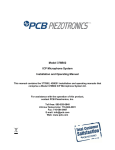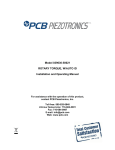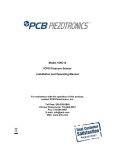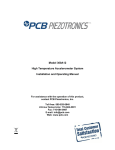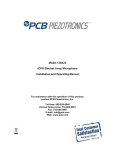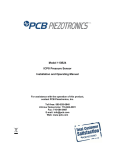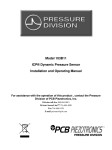Download Dynamic Distributors 122A21 User's Manual
Transcript
Model 122A21 Helium Bleed, ICP® Dynamic Pressure Sensor Installation and Operating Manual For assistance with the operation of this product , contact the Pressure Division of PCB Piezotronics, Inc. Division toll-free 888-684-0015 24-hour SensorLineSM 716-684-0001 Fax 716-686-9129 E-mail [email protected] Warranty, Service, Repair, and Return Policies and Instructions The information contained in this document supersedes all similar information that may be found elsewhere in this manual. Total Customer Satisfaction – PCB Piezotronics guarantees Total Customer Satisfaction. If, at any time, for any reason, you are not completely satisfied with any PCB product, PCB will repair, replace, or exchange it at no charge. You may also choose to have your purchase price refunded in lieu of the repair, replacement, or exchange of the product. Service – Due to the sophisticated nature of the sensors and associated instrumentation provided by PCB Piezotronics, user servicing or repair is not recommended and, if attempted, may void the factory warranty. Routine maintenance, such as the cleaning of electrical connectors, housings, and mounting surfaces with solutions and techniques that will not harm the physical material of construction, is acceptable. Caution should be observed to insure that liquids are not permitted to migrate into devices that are not hermetically sealed. Such devices should only be wiped with a dampened cloth and never submerged or have liquids poured upon them. Repair – In the event that equipment becomes damaged or ceases to operate, arrangements should be made to return the equipment to PCB Piezotronics for repair. User servicing or repair is not recommended and, if attempted, may void the factory warranty. Calibration – Routine calibration of sensors and associated instrumentation is recommended as this helps build confidence in measurement accuracy and acquired data. Equipment calibration cycles are typically established by the users own quality regimen. When in doubt about a calibration cycle, a good “rule of thumb” is to recalibrate on an annual basis. It is also good practice to recalibrate after exposure to any severe temperature extreme, shock, load, or other environmental influence, or prior to any critical test. PCB Piezotronics maintains an ISO9001 certified metrology laboratory and offers calibration services, which are accredited by A2LA to ISO/IEC 17025, with full traceablility to N.I.S.T. In addition to the normally supplied calibration, special testing is also available, such as: sensitivity at elevated or cryogenic temperatures, phase response, extended high or low frequency response, extended range, leak testing, hydrostatic pressure testing, and others. For information on standard recalibration services or special testing, contact your local PCB Piezotronics distributor, sales representative, or factory customer service representative. Returning Equipment – Following these procedures will insure that your returned materials are handled in the most expedient manner. Before returning any equipment to PCB Piezotronics, contact your local distributor, sales representative, or factory customer service representative to obtain a Return Materials Authorization (RMA) Number. This RMA number should be clearly marked on the outside of all package(s) and on the packing list(s) accompanying the shipment. A detailed account of the nature of the problem(s) being experienced with the equipment should also be included inside the package(s) containing any returned materials. PCB for a complete statement of our warranty. Expendable items, such as batteries and mounting hardware, are not covered by warranty. Mechanical damage to equipment due to improper use is not covered by warranty. Electronic circuitry failure caused by the introduction of unregulated or improper excitation power or electrostatic discharge is not covered by warranty. A Purchase Order, included with the returned materials, will expedite the turn-around of serviced equipment. It is recommended to include authorization on the Purchase Order for PCB to proceed with any repairs, as long as they do not exceed 50% of the replacement cost of the returned item(s). PCB will provide a price quotation or replacement recommendation for any item whose repair costs would exceed 50% of replacement cost, or any item that is not economically feasible to repair. For routine calibration services, the Purchase Order should include authorization to proceed and return at current pricing, which can be obtained from a factory customer service representative. Contact Information – International customers should direct all inquiries to their local distributor or sales office. A complete list of distributors and offices can be found at www.pcb.com. Customers within the United States may contact their local sales representative or a factory customer service representative. A complete list of sales representatives can be found at www.pcb.com. Toll-free telephone numbers for a factory customer service representative, in the division responsible for this product, can be found on the title page at the front of this manual. Our ship to address and general contact numbers are: Warranty – All equipment and repair services provided by PCB Piezotronics, Inc. are covered by a limited warranty against defective material and workmanship for a period of one year from date of original purchase. Contact DOCUMENT NUMBER: 21354 DOCUMENT REVISION: B ECN: 17900 PCB Piezotronics, Inc. 3425 Walden Ave. Depew, NY 14043 USA Toll-free: (800) 828-8840 24-hour SensorLineSM: (716) 684-0001 Website: www.pcb.com E-mail: [email protected] OPERATION MANUAL FOR MODELS 122A, 122A21, 122A22, and 122A24 HELIUM BLEED PRESSURE SENSOR 1.0 INTRODUCTION The series of sensors described in this guide is designed to measure dynamic pressure in intense thermal environments typified by rocket engine combustion chambers. These sensors feature acceleration-compensated piezoelectric pressure probes, mounted in a conical end seal helium bleed adaptor. The helium gas, applied from a 1500 psi source, is metered by a built-in orifice and flows around the probe body and out the passage of the adaptor ahead of the probe diaphragm. The helium gas flowing out the passage protects the sensor diaphragm from the hot gasses as well as increasing the natural frequency of the passage by a factor of approximately three to one. 2.0 DESCRIPTION The model 122A contains a one pC/psi pressure probe (sensor) and is designed to be used with electrostatic charge amplifiers such as the PCB Model 462A. The Models 122A21, A22, and A24 contain built-in impedance converter electronics circuits which convert the high-impedance voltage from the quartz crystal to a low-impedance voltage signal that can be fed directly into most common indicating or recording instruments. The 122A series sensors contain a 10 micron helium filter contained in a fitting threaded onto the helium input tube. The purpose of this filter is to prevent particles in the helium supply from plugging the metering orifice. The outer body of this series is 17-4 PH hardened stainless steel and features a conical tip for sealing without seal rings or washers. This feature also allows the sensor sensing passage to be placed closer to the chamber without a long passage that could cause resonance problems, severely limiting highfrequency response. Drawing number: 21089 Revision: NR Series 122A: Helium Bleed Rocket Motor, ICP® and Charge Sensors NOTE: The sensor probe in this series is factory installed at a precise depth in the outer body. Do not attempt removal of this probe. Contact the factory should any questions or problems arise concerning the sensor probe. The Models 122A21, A22, and A23 Sensors use low output-impedance probes (ICP) and will not require the insulation resistance cautions described for Model 122A. Connect the sensor cable to the appropriate ICP power unit and check the front panel monitor meter to check cable connections and internal amplifier. Consult Guide G-0001B, "General Guide to ICP Instrumentation" for installation and usage hints for ICP instruments. 1 OPERATION MANUAL FOR MODELS 122A, 122A21, 122A22, and 122A24 HELIUM BLEED PRESSURE SENSOR 3.0 INSTALLATION 4.0 2 OPERATION Prepare mounting port in accordance with instructions on installation drawing 122-1010-90. 4.1 Inspect the mounting port for burrs and tool marks at the conical seal surface. For the 122A Charge Output Model, it is only necessary to select the proper range on the charge amplifier and proceed with the measurement. NOTE: A 75 end-cutting reamer, Model 040A02, is available from PCB. Contact the factory for price and delivery information. Use recommended mounting torque when installing sensors. Do not overtorque as damage to seal surface could result. NOTE: When attaching helium supply hose, do not torque hose fitting through helium tube on sensor. Back up fitting with wrench on 3/8 hex on helium hose fitting. (Refer to note 3 on installation drawing.) In the presence of high vibration, support helium supply tube by clamping to rigid surfaces with adequate strain relief loop to avoid stressing helium tube on sensor. For charge output Model 122A, connect 4 ft. cable to charge amplifier and switch to "long" time constant position and check for drift. Clean offending cable connections with Trichloroethylene or equivalent solvent to restore insulation resistance. It is good practice to depress ground button (or place switch in GND" position) on the charge amplifier while attaching input cables to the amplifier. This will prevent spurious charges which may accumulate on sensors and cables from blowing out the input circuitry of the charge amplifier. Since the charge output sensors are susceptible to decreased insulation resistance, use care to keep cable connections clean by use of shrink tubing wherever possible. Drawing number: 21089 Revision: NR CHARGE 122A OUTPUT MODEL The probe sensitivity is approximately 1.0 pC/psi. (The exact sensitivity is given on the calibration certificate supplied with each instrument.) EXAMPLE: The dynamic pressure expected is 500 psi and the desired output voltage for this pressure is 1 volt. Simply set the range switch of the charge amplifier to 500 units per volt and dial the standardization pot to the exact sensor sensitivity at 500 psi (from calibration graph). The system will then yield exactly 1 volt for 500 psi of input pressure. 4.2 TIME CONSTANT During in-place calibration, static methods (dead weight tester) may be used in a drift-free system by placing the charge amplifier in "LONG TC" position. However, during actual use, the TC mode switch should be in "SHORT" position for two reasons. Often times, the dynamic pressure being measured exists superimposed upon a higher static level. The short TC position will allow the effect of this static level to zero out quickly without effect on the dynamic level indicated. Also, the influx of large amounts of thermal energy, as in rocket combustion measurements, can cause the sensor to generate spurious transient outputs of considerable magnitude. Using the charge amplifier on SHORT TC alleviates this problem by shunting these longer term charge outputs to ground while measuring the faster dynamic pressure pulses. OPERATION MANUAL FOR MODELS 122A, 122A21, 122A22, and 122A24 HELIUM BLEED PRESSURE SENSOR 4.3 OPERATION - ICP MODELS 122A21, A22, and A24 5.1 CHARGE MODEL 122A Consult Guide G-0001B for a complete description of the low-impedance concept in instrumentation. To calibrate this model, install in pressure port of dead weight tester and apply various static pressures recording corresponding outputs at each pressure of interest. All PCB power units designed for ICP use contain built-in fault monitor meters to aid in locating circuit faults (shorts or opens) and to identify normal operation of the miniature impedance converting amplifier built into the sensor. Discharge the charge amplifier before each reading and return pressure to zero before each new pressure input. Do not attempt to apply voltage directly to the input pin of the sensor from any other power source. The input current must be limited to 20 mA maximum and the input voltage must not be higher than 35 VDC. Consult the factory if it is desired to build a power unit rather than to use one of those available from PCB. The Models 122A21, 122A22 and 122A24 are identical except for sensitivity. The Model 122A21 has a sensitivity of 20mV/psi which gives a full-scale range (for +5 V out) of 250 psi. The Model 122A22 has a sensitivity of 1.0 mV/psi and a full-scale range of 5000 psi. The Model 122A24 has a sensitivity of 5.0 mV/psi and a full-scale range of 1000 psi. NOTE: Full-scale range is limited by the helium source pressure. The helium source pressure must be at least twice the peak combustion pressure (static plus dynamic) to be measured, but not more than about ten times the lowest pressure. This is true for all models, charge or ICP. 5.0 CALIBRATION Drawing number: 21089 Revision: NR Use the charge amplifier on "LONG" time constant and keep cables and connections clean to avoid drift. A D.C. digital voltmeter is ideal for readout during calibration. NOTE: The helium tube must be plugged with a pressure-tight seal before attempting to calibrate to avoid losing pressure through the helium tube. If a hydraulic calibration system is used, be sure to remove all traces of oil from the diaphragm passage. 5.2 ICP MODELS 122A21, 122A22 and 122A24 Because of the shorter time constants built into these models, static calibration methods are much more difficult to use. Pressures must be applied rapidly and readout must be made with fast recording devices such as light storage oscilloscopes or similar types of data acquisition hardware. A pneumatic (compressed air or hydrogen) system with quick opening valve and reference gage is an excellent method of calibrating these sensors. To take full advantage of the time constant built into the sensor, use a DC-coupled power unit such as the PCB Model 484B06. 3 OPERATION MANUAL FOR MODELS 122A, 122A21, 122A22, and 122A24 HELIUM BLEED PRESSURE SENSOR 6.0 GROUND ISOLATION All sensor probes in this series are mounted in an "OFF GROUND" configuration. That is, the probe body is electrically insulated from the sensor outer body to avoid ground loops. 7.0 MAINTENANCE AND REPAIR The sealed construction and miniature size of these sensors make field repair impractical. The helium filter element should be cleaned should the flow rate decrease. Remove the element and ultrasonically agitate in solvent for 15 minutes, then dry. Should the orifice become plugged, back pressure the orifice by applying air pressure to diaphragm end of sensor with filter off and helium tube vented to atmosphere. The only maintenance possible on the probe is maintaining of insulation resistance of the Model 122A probe/cable assembly. Clean connectors with suitable solvent and dry. Contact factory for assistance should problems arise. ICP is a registered trademark of PCB Piezotronics Drawing number: 21089 Revision: NR 4 OPERATION MANUAL FOR MODELS 122A, 122A21, 122A22, and 122A24 HELIUM BLEED PRESSURE SENSOR 7 Test Report Helium Flow Test and Burst Test Sensor Model ________________________ S/N __________________________ Initial Calibration: Input (PSI) System Output (V) 500 1000 1500 2000 2500 3000 1000 1500 2000 2500 3000 Burst Test to 5000 PSI - Failed Final Calibration: Input (PSI) System Output (V) 500 Helium Flow Test: Input Pressure _________ PSIG Flow Rate _________ SCFH Drawing number: 21089 Revision: NR Date: _____________________ By: _____________________













